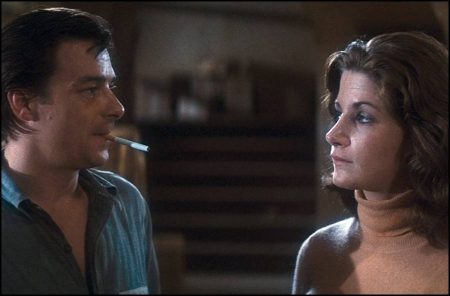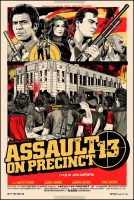Assault on Precinct 13 movie storyline. In Los Angeles, the street gangs unite and declare war to the police. Meanwhile, a father stops his car in a suburb and his daughter goes to an ice-cream truck to buy a vanilla ice-cream. She is murdered in cold blood by a member of one gang. The father follows the guy, kills him with many shots and runs to the Precinct 13. The policeman Bishop has just assumed the police station, which is not in operation but waiting to be closed on the next morning.
With him, there are two women: the telephone operator and Leigh. A few moments before the arrival of the shocked father, a bus transporting three prisoners had stopped there and the escort policemen requested cells to lock the prisoners while waiting for a doctor for one of them that is ill. Suddenly the precinct is under siege and violent attack of street gangs.
Assault on Precinct 13 is a 1976 American action thriller film written, directed, scored, and edited by John Carpenter.[2] Austin Stoker stars as a police officer who defends a defunct precinct against a relentless criminal gang, along with Darwin Joston as a convicted murderer who helps him. Laurie Zimmer, Tony Burton, Martin West, and Nancy Kyes co-star as other defenders of the precinct.
Carpenter was approached by producer J. Stein Kaplan to make a low-budget exploitation film for under $100,000, on the condition that Carpenter would have total creative control. Carpenter’s script, originally titled The Anderson Alamo, was inspired by the Howard Hawks Western film Rio Bravo and the George A. Romero horror film Night of the Living Dead. Despite controversy with the MPAA over a scene involving the violent killing of a young girl, the film received an R rating and opened in the United States on November 5, 1976.
The film was initially met with mixed reviews and unimpressive box-office returns in the United States, but when the film premiered in the 1977 London Film Festival, it received an ecstatic review by festival director Ken Wlaschin that led to critical acclaim first in Britain and then throughout Europe. It has garnered a cult following and reappraisal from critics, with many evaluating the film as one of the best action films of its era and of Carpenter’s career. A remake was released in 2005, directed by Jean-François Richet and starring Ethan Hawke and Laurence Fishburne.
About the Story
In South-Central Los Angeles, a local gang, Street Thunder, steals a cache of assault rifles and pistols. At 3 am on a Saturday in Anderson, a crime-infested ghetto, a team of heavily-armed LAPD officers ambush and kill six members of the gang. Later, the gang’s four warlords swear a blood oath of revenge against the police and the citizens of Los Angeles.
During the day, three sequences of events occur parallel to one another: First, Lieutenant Ethan Bishop, a newly promoted CHP officer, is assigned to take charge of the decommissioned Anderson police precinct during the last few hours before it is permanently closed. The station is manned by a skeleton staff composed of Sergeant Chaney and the station’s two secretaries, Leigh and Julie.
Across town, two of the Street Thunder warlords, along with two other gang members, drive around the neighborhood looking for people to kill. One of the warlords shoots and kills a little girl, Kathy, and the driver of an ice-cream truck. Kathy’s father, Lawson, pursues and kills the warlord and the other gang members chase him into the Anderson precinct. In shock, Lawson is unable to communicate to Bishop or Chaney what has happened to him.
Just before this, a prison bus commanded by Starker stops at the station to find medical help for one of three prisoners being transported to the state prison. The prisoners are Napoleon Wilson, Wells, and Caudell, who is sick. As the prisoners are put into cells, the telephone lines go dead, and when Starker prepares to put the prisoners back on the bus, the gang opens fire on the precinct, using weapons fitted with silencers.
In seconds, they kill Chaney, the bus driver, Caudell, Starker, and the two officers accompanying Starker. Bishop unchains Wilson from Starker’s body and puts Wilson and Wells back into the cells. When the gang members cut the station’s electricity and begin a second wave of shooting, Bishop sends Leigh to release Wells and Wilson, and they help Bishop and Leigh repel an attempted invasion, though Julie is killed in the firefight.
Meanwhile, the gang members remove all evidence of the skirmish to avoid attracting outside attention. Bishop hopes that someone has heard the police weapons firing, but the neighborhood is too sparsely populated for nearby residents to pinpoint the location of the noise. Wells is chosen to sneak out of the precinct through the sewer line and hot-wire a car, but is killed by a gang member hiding in the back seat. However, two police officers responding to reports of gunfire find the dead body of a telephone repairman hanging from a pole near the police station and call for backup.
Assault on Precinct 13 (1976)
Directed by: John Carpenter
Starring: Austin Stoker, Darwin Joston, Laurie Zimmer, Martin West, Tony Burton, Charles Cyphers, Nancy Loomis, Henry Brandon, Kim Richards, Peter Bruni, John J. Fox, Peter Frankland
Screenplay by: John Carpenter
Production Design by: James Nichols, John Syrjamaki
Cinematography by: Douglas Knapp
Film Editing by: John T. Chance
Art Direction by: Tommy Lee Wallace
Makeup Department: Don Bledsoe
Music by: John Carpenter
MPAA Rating: None.
Distributed by: Turtle Releasing Organization
Release Date: November 3, 1976
Visits: 264


